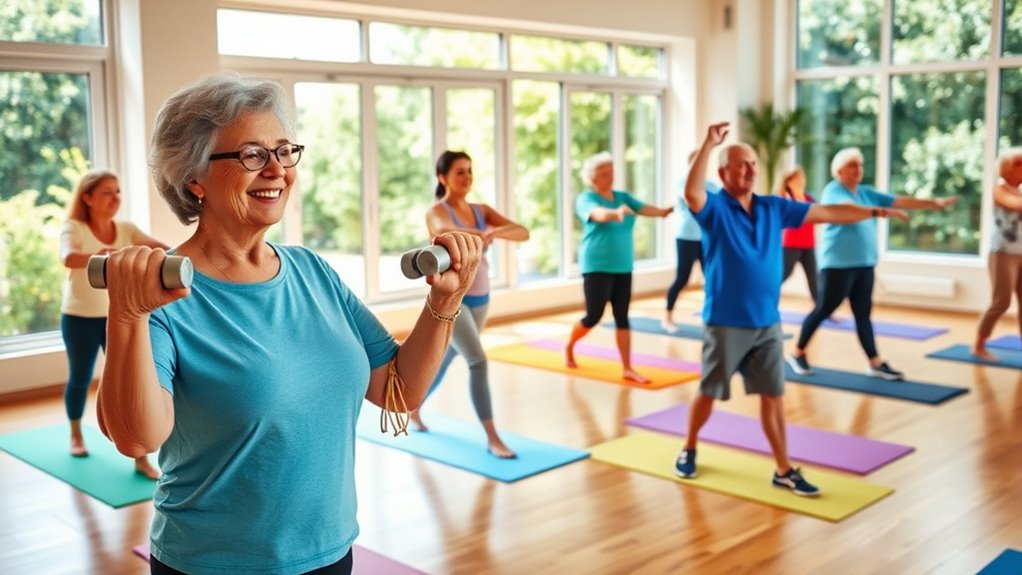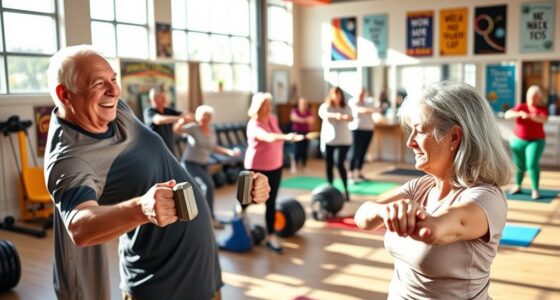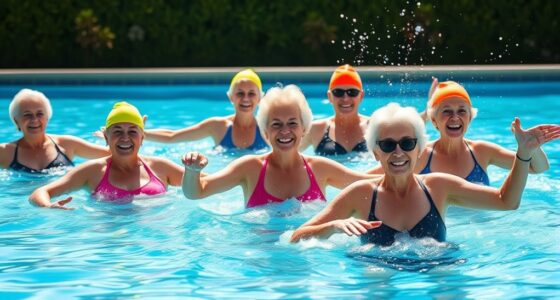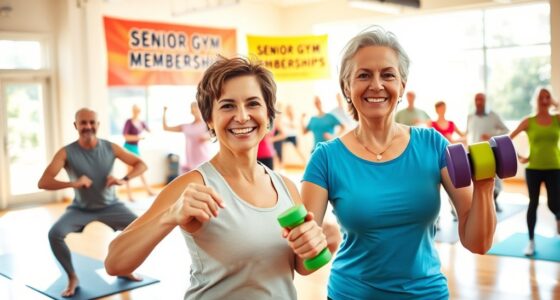Staying active is key to your health as you age. Aim for at least 150 minutes of moderate aerobic activity weekly, like walking or swimming. Don’t forget to include strength training and balance exercises on two or more days for better stability and strength. Choose activities you enjoy to keep motivation high. Always consult your healthcare provider before starting a new routine. Discover more tips and resources for a fulfilling fitness journey tailored to your needs!
Key Takeaways
- Aim for at least 150 minutes of moderate aerobic activity weekly, such as walking, swimming, or cycling, for overall health benefits.
- Incorporate strength training exercises on two or more days to maintain muscle strength and improve mobility.
- Include balance exercises like tai chi or yoga to enhance stability and reduce fall risk.
- Participate in group fitness classes like SilverSneakers or Zumba Gold for social motivation and tailored workouts.
- Consult a healthcare provider before starting any routine to ensure safety and suitability for individual health conditions.
Importance of Exercise for Older Adults
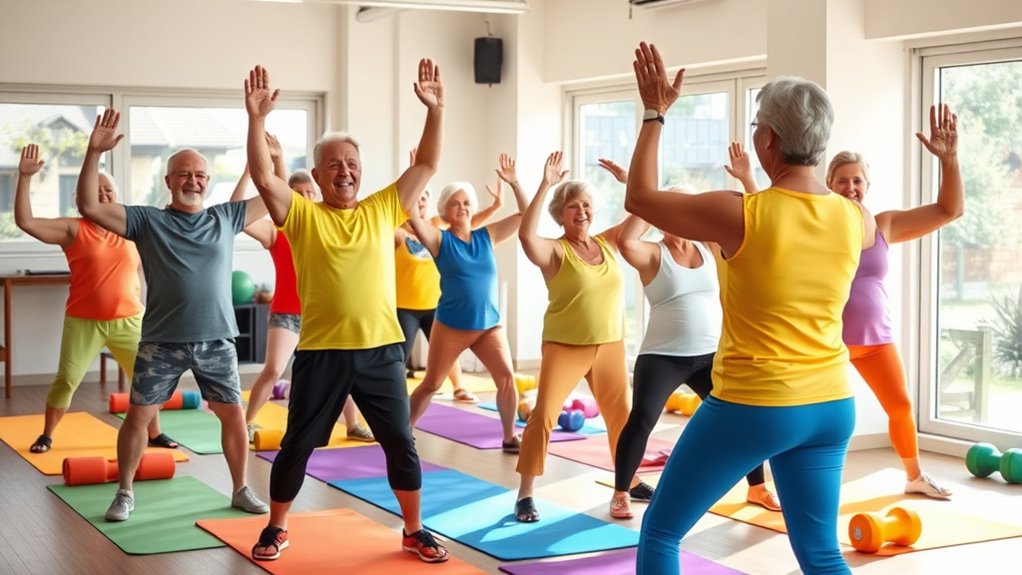
As you age, staying active becomes increasingly necessary for your overall well-being. The significance of exercise can’t be overstated; it helps maintain muscle strength, bone density, and flexibility, all essential for preventing falls. Regular physical activity also greatly improves balance, reducing the risk of injuries. Additionally, exercise plays a critical role in combating chronic conditions like heart disease and diabetes, common among older adults. Engaging in physical activity not only enhances your physical health but also boosts your mental well-being by releasing endorphins that elevate your mood and reduce stress. Furthermore, regular exercise can mitigate the effects of cognitive decline, helping to maintain mental sharpness and clarity. Effective communication about the importance of exercise can encourage older adults to adopt healthier lifestyles. Plus, regular exercise can improve sleep quality, helping you fall asleep faster and enjoy deeper rest, which is fundamental for your overall health. Furthermore, maintaining an active lifestyle can lead to long-term energy savings, making it easier to manage daily tasks and enjoy life to the fullest. Stay active, stay strong!
Recommended Weekly Exercise Schedule

To maintain your health and energy, it’s important to establish a balanced weekly exercise schedule tailored to your needs. Aim for at least 150 minutes of moderate aerobic activity each week, which can be broken into sessions of 10 to 30 minutes on multiple days. Incorporate activities like walking, swimming, or cycling for aerobic fitness. Additionally, consider engaging in outdoor activities that also allow for portable camping toilets for convenience during longer outings. Regular physical activity can help manage stress effectively while enhancing your overall well-being. Planning for your health needs in advance can also help you stay active, as having advance directives in place ensures your care preferences are respected. On two or more days, add strength training exercises, such as wall pushups and knee lifts, to maintain muscle strength. Including protein-rich meals in your diet, like the Turkey Bean and Tomato Zoodle Bowl, can support your exercise routine and aid muscle recovery. Don’t forget to include balance exercises, like single-leg stands and tai chi, to reduce your risk of falls. Finally, remember to schedule rest days to allow for recovery and prevent overexertion. Following this recommended weekly exercise schedule will help you stay active and strong. Additionally, ensuring you have a solid budget for fitness expenses can help you invest in proper gear or classes that support your health goals.
Strengthening Exercises for Seniors

Strengthening exercises are essential for seniors, especially since muscle loss can start as early as age 30. Incorporating these exercises into your routine can help maintain muscle mass and improve your overall health. Additionally, engaging in outdoor activities like hiking, fishing, and wildlife observation can complement these exercises and enhance your overall fitness. Creating a safe and supportive home environment is also crucial for encouraging regular physical activity. Studies indicate that somatic therapy techniques can further support physical and emotional well-being, making it easier to stay active. To maximize your preparations for potential emergencies, consider integrating community resilience strategies into your fitness routine.
Here are three effective options:
- Wall Pushups: Great for upper body strength, they’re easy to perform and reduce the risk of falls.
- Chair Squats: These help strengthen your legs and core, important for maintaining balance and mobility.
- Abdominal Contractions: This exercise improves core stability, vital for reducing falls and managing chronic conditions.
Aim for regular exercise at least two days a week to enhance bone density and keep you strong. Additionally, routine health checks can help monitor your overall well-being and address any concerns early on.
With these strengthening exercises, you’ll not only feel better but also enjoy a more active lifestyle.
Stretching and Balance Exercises

In addition to strengthening exercises, incorporating stretching and balance routines can greatly enhance your overall fitness and well-being.
Daily stretching exercises, like neck stretches and shoulder blade squeezes, improve flexibility and reduce muscle tension, helping you maintain a greater range of motion. Positive thinking can also play a crucial role in overall mental health, as it helps in maintaining a constructive mindset. Engaging in spiritual retreats can further enhance your mental clarity and emotional resilience, while practicing self-care techniques can also contribute to improved emotional health.
Balance exercises, such as single-leg balance and weight shifting, enhance stability and coordination, considerably lowering your risk of falls and injuries.
Engaging in tai chi or yoga not only promotes balance but also improves mental focus, contributing to both physical and mental health. Regularly practicing these balance exercises multiple times each day is essential for fall prevention and maintaining independence.
Additionally, incorporating pet therapy into your routine can further support emotional well-being and social interaction, which are vital for overall health.
Make sure to include stretching and balance routines in your weekly exercise plan for ideal health and mobility.
Choosing the Right Activities
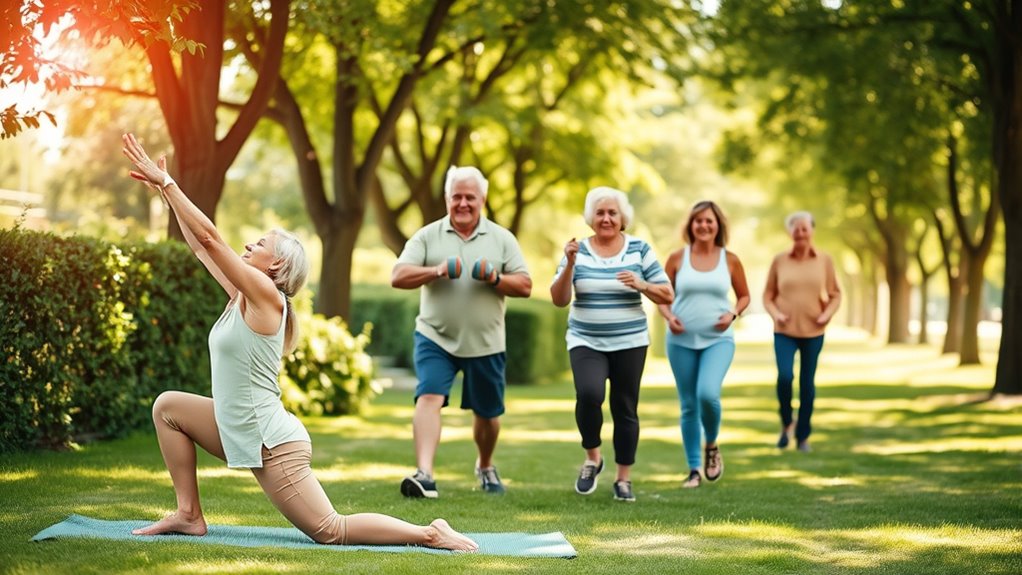
When choosing activities, consider what you enjoy most to keep your workouts engaging. Low-impact exercises, like swimming or cycling, are great options that protect your joints while still offering significant benefits. Additionally, maintaining a clean and organized environment can enhance your motivation and focus during workouts, contributing to a healthier lifestyle. Regular grooming of pets, for example, can help reduce distractions from pet hair management during your exercise routine. Engaging in regular physical activity is also essential for preventing behavioral issues, promoting both mental and physical well-being as you age. Incorporating solar-powered solutions into your home can further support an active lifestyle by providing convenient energy for outdoor workouts or activities. Moreover, staying hydrated is crucial for maintaining energy levels and overall health during exercise, as proper hydration techniques significantly enhance physical performance.
Assessing Personal Preferences
How do you choose activities that you’ll enjoy and stick with? Start by considering your interests and physical capabilities.
To help you assess personal preferences, here are three key steps:
- Assess physical limitations: Consult with a healthcare provider to understand what exercises suit your health needs. Additionally, consider how tax implications can impact your ability to maintain a consistent exercise regimen as it may affect your access to certain facilities or classes.
- Explore group exercise classes: Join options like SilverSneakers or yoga, which not only improve balance but also provide social support to keep you motivated.
- Mix it up: Incorporate aerobic, strength, flexibility, and balance exercises to create a well-rounded fitness routine that promotes an active lifestyle.
Importance of Low-Impact Exercises
Finding activities you enjoy is the first step toward maintaining an active lifestyle, but it’s equally important to choose low-impact exercises that protect your joints and overall health.
These exercises, like swimming and cycling, effectively improve cardiovascular health while reducing stress on your joints. Activities such as walking, yoga, and tai chi enhance balance and flexibility, which are essential for preventing falls as you age.
By incorporating low-impact workouts into your routine, you’re not just strengthening your muscles but also greatly improving your quality of life. Research shows that active individuals have a 46% lower mortality risk compared to sedentary peers.
Aim for 150 minutes of moderate-intensity activity weekly to help seniors maintain their well-being and vitality.
Tips for Staying Motivated
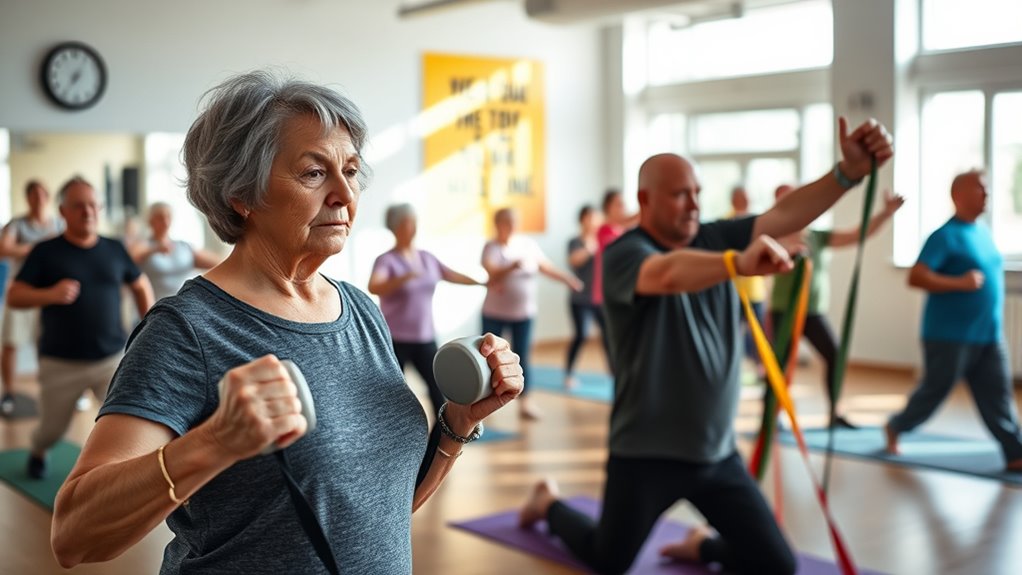
Staying motivated to exercise as you age can feel challenging at times, but there are effective strategies to keep you on track.
Here are three tips to help you stay strong and engaged:
- Set Achievable Goals: Establish realistic fitness goals that encourage progress. This helps prevent discouragement as you work towards your activity milestones.
- Find a Workout Buddy: Exercising with a friend boosts enjoyment and accountability, making it easier to stick to your routine.
- Reward Yourself: Celebrate your achievements with small incentives. Treating yourself after hitting a goal reinforces a positive association with staying active.
Group Fitness Classes and Resources
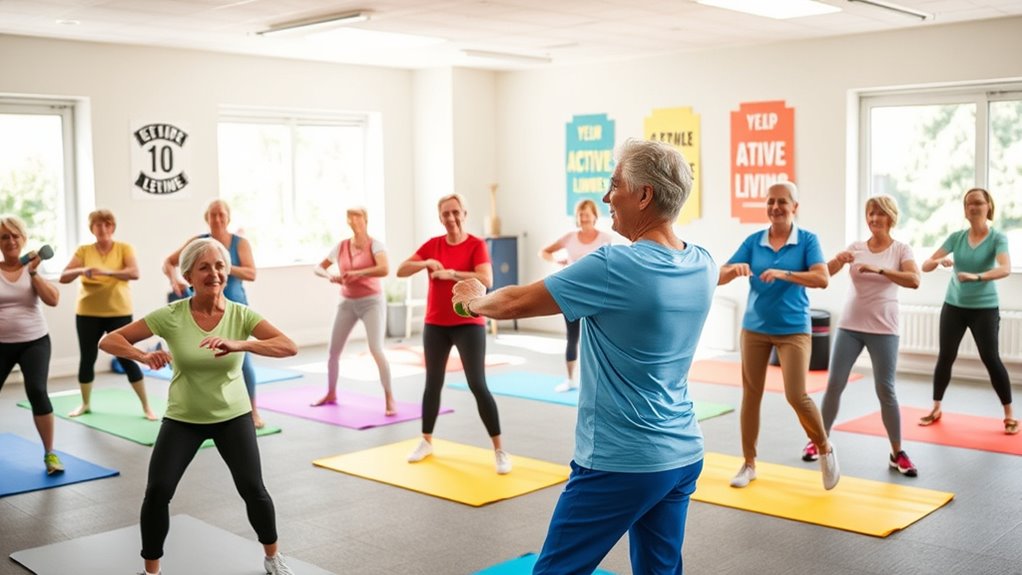
Group fitness classes offer a variety of options tailored to your needs, from seated yoga to Zumba Gold, making it easy to find something you enjoy.
Plus, with resources like SilverSneakers’ On-Demand videos, you can access classes from home whenever it suits you.
Embracing these opportunities can enhance your fitness journey while connecting you with a supportive community.
Class Variety Options
When you explore class variety options, you’ll discover that specialized fitness classes for older adults can markedly enhance your workout experience.
These group classes not only promote social interaction but also keep you motivated in your health and fitness journey.
Here are some great fitness options to take into account:
- SilverSneakers Classic – Focuses on strength and flexibility, ensuring exercises are safe and effective.
- Zumba Gold – A fun, low-impact dance class that gets your heart pumping while you enjoy music.
- Line Dancing – An engaging way to improve balance and coordination in a lively setting.
Online Access Benefits
With the rise of online fitness options, older adults can now enjoy the convenience of participating in group classes from home. SilverSneakers LIVE offers live-streamed workouts, making exercise accessible and enjoyable. You can also activate a free online account, giving you access to a variety of fitness resources, including hundreds of On-Demand videos. This allows you to engage in various workouts at your convenience while fostering social interaction with others.
| Benefits of Online Access | Description |
|---|---|
| Convenience | Participate in classes from home |
| Variety of Classes | Access to yoga, Zumba Gold, and more |
| Social Interaction | Connect with peers virtually |
| Accountability | Stay motivated through group settings |
| On-Demand Resources | Hundreds of videos available |
Safety and Health Considerations

Before diving into any exercise routine, it’s essential to consult your healthcare provider. This guarantees your plan aligns with your unique health conditions and physical limitations.
Consulting your healthcare provider before starting any exercise routine ensures your plan suits your health needs and limitations.
Here are some key safety and health considerations:
- Medical Identification: Wear a medical bracelet to inform healthcare professionals about any existing conditions during physical activity.
- Proper Form: Always perform exercises with proper form to minimize injury risk and enhance workout effectiveness.
- Balance Training: Incorporate balance training into your routine to greatly reduce the risk of falls and related injuries.
Frequently Asked Questions
Which Type of Exercise Is Most Strongly Recommended for Older Adults?
When it comes to exercise for older adults, aerobic activities are the most strongly recommended. You should aim for at least 150 minutes of moderate-intensity exercise each week, like walking, swimming, or cycling.
These activities boost your cardiovascular health and overall well-being. Incorporating strength training and balance exercises is also essential, but starting with regular aerobic workouts will lay a strong foundation for your fitness journey.
Enjoy staying active!
What Is the Best Exercise Routine for Seniors?
Imagine you’re back in the ’70s, grooving to disco while getting fit!
The best exercise routine for you includes 150 minutes of moderate-intensity aerobic activity weekly, like brisk walking or swimming.
Add strength training twice a week to target major muscle groups, plus flexibility and balance exercises like yoga or tai chi.
These activities not only boost your strength and mobility but also help prevent falls, keeping you active and vibrant!
How Can Older Adults Stay Active?
To stay active, you can aim for at least 150 minutes of moderate aerobic activity weekly, like walking or swimming.
Incorporate strength training twice a week with simple exercises, such as wall pushups and chair squats.
Don’t forget balance exercises, like tai chi, to improve stability and reduce fall risks.
Short, frequent sessions of 10 to 15 minutes can fit easily into your day, and joining group classes can boost your motivation and enjoyment!
How Can an Elderly Person Get Stronger?
So, you think lifting your grocery bags counts as strength training? Think again!
To get stronger, you’ve gotta embrace some actual exercises. Try bodyweight workouts like wall pushups or chair squats – they’ll work wonders!
Toss in some balance moves like tai chi, and you’ll be the envy of your neighborhood.
Just remember, check in with your doctor first; they’ll help you create a plan that suits your unique needs.
Now, let’s get stronger!
Conclusion
Staying active isn’t just about maintaining strength; it’s about enhancing your overall quality of life. By incorporating regular exercise into your routine, you’re not only boosting your physical health but also your mental well-being. So, why not start today? Whether it’s strength training, stretching, or joining a group class, there’s something for everyone. Remember, the key is consistency and enjoyment. Embrace this journey and see how much stronger and more vibrant you can feel as you age!
